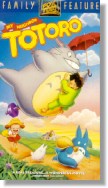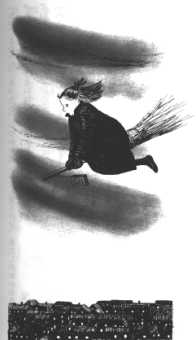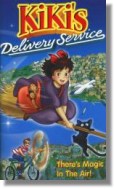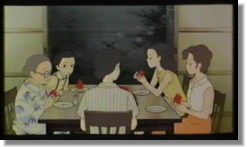![]()
Look Who's Coming to Dinner...
or: Pot Shots: Part Deux
by Akio Nagatomi (e-mail: master@abcb.com)
This past month marked the beginning of a very important event: the release of English-dubbed Japanese animation by an entertainment company with very deep pockets. One cannot ignore the importance of this event. Japanese animation has suddenly been handed a degree of legitimacy -- after all, this is Disney. Add to this the addition of giant Bandai on the scene, and you can bet that the smaller players who created this niche market are very, very nervous.
Its a tough industry, and not every company has survived its infancy. We've seen some fall-out from the increasing visibility of the anime market already. Streamline Pictures has sold much of their holdings to Orion Pictures. Some, such as US Renditions have either been acquired by other companies, or have simply gone by the wayside. Others have had to greatly reduce the number of titles that they release every year. The commercial entertainment industry had begun to notice the largely untapped otaku market, previously serviced by small-time operators and the underground fan-subbed services. Several companies forsaw what was coming, and either formed strategic alliances, or consolidated amongst each other. Those that didn't are no more...
A Tale of Two Dubs.

Many would point to Fox Entertainment's brief foray into this venue with their well-received My Neighbor Totoro as the first of the big ventures, but in that particular case, Fox merely re-packaged an existing product originally produced by Carl Macek and Troma, Inc. Manga Entertainment's and Bandai's joint effort with Ghost in the Shell appears to be a one-off, short term marketing arrangement. Not so with Disney. Buena Vista Home Entertainment's in-house resources brought on some of Hollywood's more recognisable names, in order to draw the attention of the public at large. Debbie Reynolds. The late character actor, Phil Hartman. Young acting prodigy Kirsten Dunst. Matthew Lawrence. These and others were brought together in a project involving a timeless children's story written by Kadono Eiko: the very respected Majo no Takyubin, or Kiki's Delivery Service as it's better known in North America. These folks are in it for the long run.

Disney was not given free reign, however. Miyazaki Hayao, perhaps still smarting from New World Picture's botched make-over of Warriors of the Wind (the film formerly known as Kaze no Tani no Nausicaa), had in effect veto power over all aspects of editing. This doesn't mean that the original production was left intact -- far from it, in fact. The English script is a very liberal translation of the original. The score has been substantially re-arranged, with several incidental pieces replacing parts of the original Joe Hisaishi score, and two all-new, original pieces subplanting the Japanese opening and ending themes. References to the colour of Kiki's outfit have been written out of the screenplay entirely. Subjects undesireable in our Western culture have been removed, and substituted with more 'acceptable' dialog. (For example, Osono prepares 'hot chocolate' for Kiki the first time they meet, instead of coffee. I certainly hope that Osono keeps marshmallows in her sugar bowl!) In sharp contrast, the Fox/Troma production stayed true in both form and intent to the original Japanese release. Even though the original opening and closing themes had been re-written for the English market, the original feel, intent -- even the sound of the singer's voice -- were kept remarkably similar. The only real similarities between the Fox approach and Disney's are really in the way of visual packaging -- both video covers look like they could have been designed by the same advertising agency.
It's pretty clear that Disney means to mainstream these Japanese imports, making them more accessible, more acceptable to the North American market. But what does this really do the the anime market as a whole?
The Color of Money.

In re-editing these classics of Japanese animation, Disney gains a marketing edge -- no longer are these titles considered obscure works of anime; instead, they've become foreign-produced animation. This distinction is vital to their marketing plans; after all, there's quite a stigma attached to the term 'anime,' and to the anime market as a whole. Disney has made their mark being identified as a wholesome, family-oriented entertainment business. Anime, many feel, is not. Simply put: Disney can make a lot more money by maximizing the market potential of any particular title, thus assuring the longevity of the market itself. Ironically, proponents of dubbed anime have been saying this for years.
This is not new territory for Disney. After all, they had taken the dark, somewhat sombre tale of a young mermaid and turned it into a musical, completely devoid of Hans Christian Anderson's moral issues. But did The Little Mermaid ever sell! Similarily, Disney hopes that by removing as many cultural references and concepts undesireable to the North American audience, Kiki's will be a success. In this repect, the Disney release has a huge advantage over the previous Fox film: Kiki's Delivery Service takes place in a ficticious land modelled after Europe, not the heart of the Japanese farming community as in the case of Totoro.
Ordinary People.
You can pretty much bet that the larger Japanese production companies are viewing this great interest -- after all, if this approach means larger returns for Disney, it also means larger potential licensing agreements. As a toy manufacturer, Bandai is not blind to what this means in terms of spin-off sales. Expect their influence to expand greatly, especially now that they're releasing anime titles themselves. What does this mean to the industry as a whole? Personally, I think that we'll see yet another culling of dubbed and subtitled anime producers in North America. The big, commerically attractive theater releases will get gobbled up by the companies with the deepest pockets, and the Japanese producers are going to expect bigger licensing agreements than what they're getting now. Those titles will end up unrecognisable as anime -- modern day Speed Racers. Perhaps we'll see more joint ventures, such as the Shogakukan-sponsored VIZ Video. Independant companies such as Central Park Media and A.D. Vision will end up scrapping for left-overs, unable to afford the more popular titles -- they'll pick up the scraps that the giants aren't interested in, and their choices will be very limited. In the end, the niche anime market will remain just that -- only with a smaller selection than what we've come to expect.
The Final Analysis.

Is this good or bad for the anime industry? Well, that will depend on your point of view. Mainstreaming the Japanese-made product will make things much more accessible to the general public. This in turn will open the door for a much wider variety of material. But I can see a few downsides to this as well. Inevitably, there will be some form of editing involved. As such, we'll end up with an 'Edited for TV' product which may not contain information that the original writers had intended. But the thing that will take the biggest hit is what many an otaku have already discovered: the fascinating differences between our Western and Eastern cultures. No longer will we notice that young Japanese girls do indeed drink coffee, and that the Japanese society still practise formalised greetings, or say itadakimasu before eating a meal -- unlike the 'typical' dysfunctional family as portrayed in the Simpsons. These differences are all part of the curiosity which fuels the current popularity of anime. With the increased distribution, I think that popular titles will be less likely to be subtitled. Sure, major screen productions will continue to be subbed -- after all, we can find easily find original language versions of Das Boot, Camille Claudelle or even Tampopo at many rental houses. But, if the returns on the dubbed product turn out to be much better than the sub, why even bother with the extra cost of a separate production run?
I certainly hope that this is not the case -- after all, what would happen to all the closet (and not-so-closet) voice-actor groupies out in otaku-land? What would Slayers be like without Hayashibara Megumi? (Don't answer that -- I already know!) Whereas the world may become increasingly globalised in economic interests, we shouldn't forget that it's our individual differences which gives human society such a rich, diversified culture. The French have a saying that states this best: "Vive la difference!"
- Akio Nagatomi, 1998.10.10
[ << prev ] [ top ] [ next >> ]
[ what's new ] [ editorials ] [ calendar ] [ to do ] [ in the news ] [ mailbag ] [ archives ]
[ home ]
[ what's new ]
[ café contest ]
[ café reviews ]
[ parent's guide ]
[ encyclopædia ]
[ café trivia ]
[ café latté ]
[ café espresso ]
[ about the café ]
[ feedback ]
[ links ]
[ site map ]
© 1997-2000. All rights reserved. The Animé Café logo and the Crystal Kyoko award are original creations of the Animé Café. Please do not use any of the materials on this site without the expressed written permission of the Animé Café.
The editorial opinions expressed on this page are just that -- opinions of the author. No statement of fact, unless specifically quoted, is implied.
Page last modified 1998.10.18
